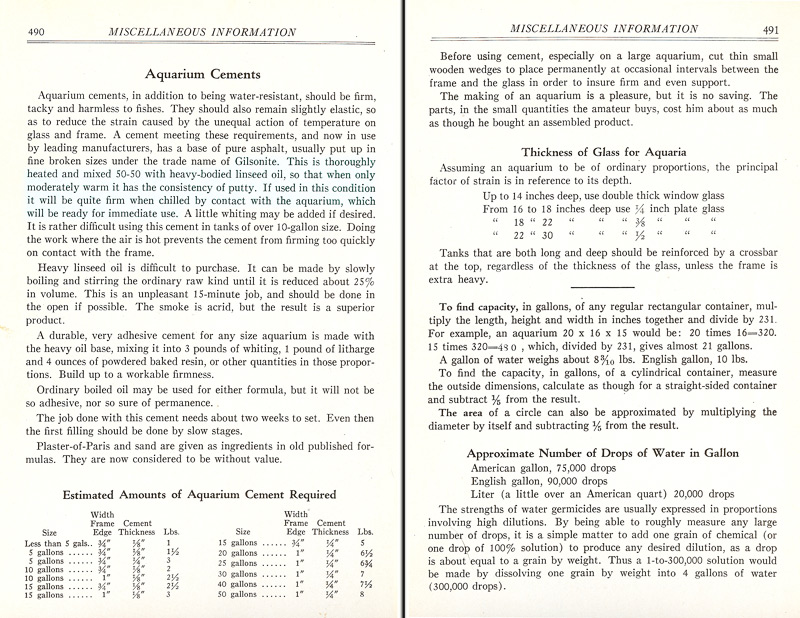Stainless Steel Slate Bottom Aquariums
When I was a kid, this was the only aquarium choice: stainless steel frame with a slate bottom. I remember my seventh grade science teacher had several big stainless framed aquariums, probably 50-60 gallons each. All of them leaked a little. They had cool looking matching stainless light hoods that would instantly blister the skin on your hands if you touched them, being heated from the regular incandescent bulbs inside. As an 11 year old, my dream was to have a couple of those big tanks some day...
The slate bottom aqauriums came in a ton of different sizes, and were made primarily by Metaframe, Pemco, and Sternco, with a large number of "no-name" knock-offs. Below are 20, 10, 4, and 2.5 gallon tanks. A very small sample of the several dozens of sizes made.
There are construction differences between all the various knock-offs, the Metaframe tanks, and the older Pemco tanks. I took some pics of the various types of tanks, focusing on methods of frame construction. Links below:
These tanks used a black tar-like goop to seal the glass to the frame and slate. Unfortunately, after 30-50 years, (unless the tank has been full of water the entire time) the stuff is mostly dried out. This means leaking tanks. The original method of fixing the leaks was to fill the tank with very hot water and let it stand. The sealer goop would soften up and heal itself. Pretty cool stuff. These days however, especially if the tank has been dry for a while, there aren't enough volatiles left in the goop to soften and reseal the tank with the hot water method.
I've collected quite a few of these tanks, and have seen many attempts by previous owners to use silicone to reseal the joints. It might work for a while, but silicone doesn't stick to slate for very long, and, nearly all the silicone repair jobs are horribly done.
A proper repair means completely disassembling the aquarium. Using a heat gun, a putty knife and a -LOT- of patience, the slate bottom and then all the glass can usually be removed intact. The trick is to heat the entire frame area around the slate or glass, and slowly work the putty knife beltween the glass and frame, -without any prying-. Figure 15-20 minutes for each pane in a smaller (5 gallon) tank.
After the slate and glass is out, the fun really begins. The black goop needs to be removed. First, use the heat gun and a couple paint stir sticks to get most of it out. Then use a tar disolving solvent to get out the rest. I used carburetor cleaner and soaked each side for bit. This softened the goop enough to be brushed out. Do this outdoors, of course. Preferably in a breeze.
Once all the goop is out, and the frame cleaned, you might think about new glass. After 30-50 years, it is invariably scratched up. If you managed to get all the glass out in one piece, take measurements of the front/back, and sides, noting the thickness. Also, if you plan on using black aquarium silicone, measure the slate bottom and have a piece of thick plate cut to replace the slate. At this point, you'll realize you should have buffed/polished the frame with the old glass still in it...
For the purists, you can make NEW black goop and faithfully restore the tank to its original "as sold" form, using the cleaned frame, new glass and original slate bottom. What is the black goop made of? I spent some time researching that one.
Below is a scan of the "Miscellaneous Information" page from my 5th edition William T. Innes book "Exotic Aquarium Fishes" (originally written 1935, 5th edition published in 1944), featuring two goop recipes. The first recipe is the one we are interested in. Gilsonite is available today, and there are often one to five pound bags for sale on ebay. Also note that the "thickened linseed oil" mentioned is not the same as today's "boiled linseed oil". Modern boiled linseed oil is used as a wood finish, and has metallic drying agents added. To successfully recreate Innes' original "heavy/thickened oil", you'll need a gallon or so of raw linseed oil (flaxseed oil), a disposable pot, a camp stove, and follow Innes' instructions for making "thickened linseed oil". The second recipe calls for a pound of litharge (lead powder), so we can safely forget about that particular goop blend. The bottom of the left page also lists the amount of black goop needed, by tank size.
Being a good uncle means giving the nieces and nephews Christmas and birthday presents that the parents dread their children having: drums, canoes, computers... vintage aquariums. But it also means getting quality stuff, like an aquarium that won't leak.
For me, since I'm giving these tanks away to the kids, I'll be using black aquarium silicone and a plate glass bottom instead.Below is the finished 2.5 gallon tank. New glass, the slate bottom was also replaced with a piece of plate glass, the tank is sealed with black silicone. The slate botton was cleaned and placed loose in the bottom. I found an old Metaframe style hood. Originally, using incandescent bulbs, these hoods would become dangerously hot to touch. However, using a small diameter CFL, they are fine.
Below shows a 5500k 14w small diameter spiral CFL lighting the tank. Ready to go...



